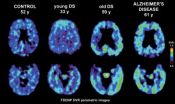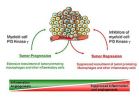(Press-News.org) In one of the first studies of its kind, UCLA researchers used a unique brain scan to assess the levels of amyloid plaques and neurofibrillary tangles — the hallmarks of Alzheimer's disease — in adults with Down syndrome.
Published in the June edition of the Archives of Neurology, the finding may offer an additional clinical tool to help diagnose dementia in adults with Down syndrome, a genetic disorder caused by the presence of a complete or partial extra copy of chromosome 21.
Adults with this disorder develop Alzheimer's-like plaque and tangle deposits early, often before the age of 40. Previously, the only way to physically detect these abnormal proteins in this population was through an autopsy.
Over the last decade, methods for identifying and imaging the neuropathology of Alzheimer's disease in living patients have been developed. UCLA researchers have created a chemical marker called FDDNP that binds to both plaque and tangle deposits, which can then be viewed through a positron emission tomography (PET) brain scan, providing a "window into the brain." Using this method, researchers are able to pinpoint where in the brain these abnormal protein deposits are accumulating.
Due to individual variability and difficulty in obtaining baseline levels of cognitive function in adults with Down syndrome, such imaging may be useful in helping to diagnose dementia, say researchers.
"Neuroimaging may be a helpful tool in assessing and tracking plaque and tangle development over time in this population," said the study's senior author, Dr. Gary Small, a professor at the Semel Institute for Neuroscience and Human Behavior at UCLA who holds UCLA's Parlow-Solomon Chair on Aging. "Early detection can also lead to earlier interventions and treatments, often before symptoms begin."
For this study, researchers administered the FDDNP chemical marker intravenously and then performed PET brain scans on 19 non-demented adults with Down syndrome (average age 37), 10 healthy controls (average age 43) and 10 patients with Alzheimer's disease (average age 66).
Analysis found significantly higher binding levels of the chemical marker in participants with Down syndrome in all brain regions, when compared with healthy controls. Compared with Alzheimer's disease patients, subjects with Down syndrome showed significantly higher binding levels in the parietal and frontal regions — areas involved in memory, behavior and reasoning.
"The higher level of plaques and tangles may be reflecting the early and extensive accumulation of these deposits seen in individuals with Down syndrome," Small said.
The researchers also discovered significant associations between increased age in those with Down syndrome and higher FDDNP binding values in the parietal, lateral temporal and frontal regions.
"This is one of the first times we've been able to visualize the neuropathology occurring in the living brains of adults with Down syndrome," said study author Dr. Jorge R. Barrio, a professor of molecular and medical pharmacology at the David Geffen School of Medicine at UCLA who holds UCLA's Plott Chair in Gerontology. "The age-related patterns and regional distribution of the plaques and tangles were consistent with the types of deposits that could only be identified previously through an autopsy."
While the FDDNP brain scans didn't differentiate between the two types of abnormal proteins, the areas of accumulation were consistent with earlier autopsy study findings, which had shown that while plaque and tangle pathologies are the same in both Down syndrome and Alzheimer's disease, the deposit patterns are different.
Autopsy studies have also shown that all adults with Down syndrome eventually develop these accumulations of amyloid plaques and tau tangles. But rather than experiencing memory decline and other cognitive losses, as is common with Alzheimer's, aging Down syndrome patients tend to develop behavioral problems.
As part of the study, researchers performed cognitive and behavioral assessments of the Down syndrome subjects to see if FDDNP binding levels correlated with assessment results. They found several positive correlations with behavior abnormalities associated with these brain changes, including indifference and inappropriateness.
"We found that the behavioral changes in the subjects with Down syndrome correlated with neurological changes in related areas of the brain consistent with the level of FDDNP binding levels to the abnormal proteins," Small said.
Small noted that cognitive skills in people with Down syndrome vary considerably and may not have been captured completely in the assessment, which primarily measured memory function. Larger future studies will compare other cognitive tests with FDDNP binding values, he said.
In addition, researchers plan to determine the relative benefits of different forms of PET imaging using various chemical markers, including FDDNP.
INFORMATION:
This study was supported by the National Institutes of Health and the U.S. Department of Energy.
UCLA owns three U.S. patents on the FDDNP chemical marker. The Office of Intellectual Property at UCLA is actively seeking a commercial partner to bring this promising technology to market.
Small, Barrio and study author S.C. Huang are among the inventors. Disclosures are listed in the full study.
Additional UCLA study authors include Linda D. Nelson, Prabha Siddarth, Vladimir Kepe, S.C. Huang and Kevin E. Scheibel.
For more news, visit the UCLA Newsroom and UCLA News|Week and follow us on Twitter.
Brain scan identifies patterns of plaques and tangles in adults with Down syndrome
2011-06-14
ELSE PRESS RELEASES FROM THIS DATE:
Chillingham cattle cowed by climate change
2011-06-14
Spring flowers are opening sooner and songbirds breeding earlier in the year, but scientists know little about how climate change is affecting phenology – the timing of key biological events – in UK mammals. Now, a new study on Northumberland's iconic Chillingham cattle published in the British Ecological Society's Journal of Animal Ecology shows climate change is altering when these animals breed, and fewer calves are surviving as a result.
The team of ecologists lead by Dr Sarah Burthe of the Centre for Ecology & Hydrology were able to use the cattle to discover more ...
Pacemaker implantation for heart failure does not benefit nearly half of the patients
2011-06-14
A new meta-analysis study, led by physician researchers at University Hospitals (UH) Case Medical Center and Case Western Reserve University School of Medicine, and to be published in the Archives of Internal Medicine (embargoed until June 13, 4 p.m. EDT), shows that three-lead cardiac pacemakers implanted in those with heart failure fail to help up to 40 percent of patients with such devices.
"These findings have significant clinical implications and impact tens of thousands of patients in the U.S.," said Ilke Sipahi, MD, Associate Director of Heart Failure and Transplantation ...
Genetic factor controls health-harming inflammation in obese
2011-06-14
CLEVELAND – June 13, 2011 –Researchers at Case Western Reserve University School of Medicine have discovered a genetic factor that can regulate obesity-induced inflammation that contributes to chronic health problems.
If they learn to control levels of the factor in defense cells called macrophages, "We have a shot at a novel treatment for obesity and its complications, such as diabetes, heart disease and cancer," said Mukesh K. Jain, MD, Ellery Sedgwick Jr. Chair, director of the Case Cardiovascular Research Institute, professor of medicine at Case Western Reserve University ...
Promising new target for stifling the growth and spread of cancer
2011-06-14
Cancer and chronic inflammation are partners in peril, with the latter increasing the likelihood that malignant tumors will develop, grow and spread. Researchers at the University of California, San Diego School of Medicine say they've identified a tumor inflammation trigger that is common to most, if not all, cancers. And using existing inhibitory drugs, the scientists were able to dramatically decrease primary tumor growth in animal studies and, more importantly, halt tumor progression and metastasis.
The findings appear in the June 14 issue of the journal Cancer Cell, ...
Type 2 diabetes linked to higher risk of stroke and CV problems; metabolic syndrome isn't
2011-06-14
CHICAGO – Among patients who have had an ischemic stroke or transient ischemic attack (TIA), type 2 diabetes was associated with an increased risk of recurrent stroke or cardiovascular events, but metabolic syndrome was not, according to a report published Online First today by Archives of Neurology, one of the JAMA/Archives journals.
Previous research has examined the association between cardiovascular incidents and these conditions, according to background information in the article. "Type 2 diabetes mellitus is associated with increased risks of both stroke and coronary ...
Expenditures for glaucoma medications appear to have increased
2011-06-14
CHICAGO – In recent years, spending for glaucoma medications has increased, especially for women, persons who have only public health insurance and those with less than a high school education, according to a report published Online First by Archives of Ophthalmology, one of the JAMA/Archives journals.
Glaucoma is a condition marked by damage to the optic nerve, and is a leading cause of blindness. According to background information in the article, approximately 2.2 million individuals ages 40 years and older in the United States currently have primary open-angle glaucoma; ...
Dietary changes appear to affect levels of biomarkers associated with Alzheimer's disease
2011-06-14
###
(Arch Neurol. 2011;68[6]:743-752. Available pre-embargo to the media at www.jamamedia.org.)
Editor's Note: This research was supported by grants from the National Institute on Aging and by funding from the Nancy and Buster Alvord Endowment. This article results from work supported by resources from the Veterans Affairs Puget Sound Health Care System. Please see the article for additional information, including other authors, author contributions and affiliations, financial disclosures, funding and support, etc. ...
Study estimates potential for ranibizumab to prevent blindness from age-related macular degeneration
2011-06-14
A computer modeling study suggests that administering the drug ranibizumab is associated with reducing the magnitude of legal blindness and visual impairment caused by age-related macular degeneration in non-Hispanic white individuals, according to a report in the June issue of Archives of Ophthalmology, one of the JAMA/Archives journals.
"Before ranibizumab became available in 2006, neovascular age-related macular degeneration (AMD) was reported to be the leading cause of blindness in individuals 50 years and older in the United States and throughout many parts of the ...
Article outlines principles for a conservative approach to prescribing medication
2011-06-14
CHICAGO – A shift toward more conservative medication-prescribing practices would serve patients better, according to a review article published Online First today by Archives of Internal Medicine, one of the JAMA/Archives journals. The article is part of the journal's Less Is More series.
As background, the article notes that the majority of patients under age 65 years receive at least one prescription drug annually. However, according to the authors, not every patient visit needs to result in a prescription. They point to "the recent spate of revelations of undisclosed ...
Studies evaluate criteria for detecting potentially inappropriate medicines
2011-06-14
CHICAGO – Using the Screening Tool of Older Persons' potentially inappropriate Prescriptions (STOPP) criteria was associated with identification of adverse drug events in older patients, according to a report in the June issue of Archives of Internal Medicine, one of the JAMA/Archives journals. The article is part of the journal's Less Is More series.
According to information in the article, adverse drug events (ADEs) are a significant issue in the older population, and are thought to represent an important cause of hospitalization and account for substantial health care ...


